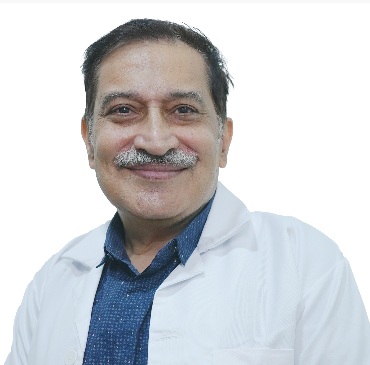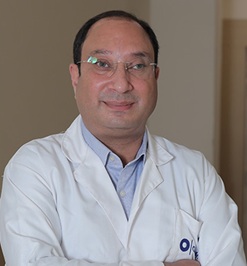Arthroscopy Surgery - Procedure, Benefits and Recovery

Treatment Duration
30 Minutes
------ To ------45 Minutes
Treatment Cost
₹ 45,000
------ To ------₹ 2,00,000

Table of Contents
Arthroscopy is a surgical procedure to diagnose or treat problems in the joints. It is minimally invasive, where the surgeon makes a small incision to insert an arthroscope to view inside the joint. It is also known as Keyhole Surgery.
Arthroscopy surgery is used on the knees, ankles, hips, shoulders, wrists and elbows. It is a daycare procedure, and the patient is discharged within 24 hours. The recovery after the surgery is quick and effortless.
| Surgery Name | Arthroscopy |
| Alternative Name | Keyhole surgery |
| Disease Treated |
Loose bone fragments, Joint inflammation or scarring, Torn ligaments |
| Benefits of the Surgery | Minimally invasive, Quick recovery, Less pain |
| Treated by | Orthopaedic surgeon |
You can check Arthroscopy Cost here.
What is Arthroscopy?
Arthroscopy is a surgical procedure to diagnose or repair the structural problems of a joint. The surgeon inserts a narrow tube into a fibre-optic video camera through a small incision (about the size of a buttonhole attached) to view inside the joint.
The arthroscopy procedure is most commonly done for the following:
- Knee arthroscopy for knee
- Elbow arthroscopy for elbow
- Shoulder arthroscopy for shoulder joints
- Ankle arthroscopy for ankle
- Hip arthroscopy for hip
- Wrist arthroscopy for wrist conditions
Anatomy and Physiology of Joints in the Human Body
A joint in the human body is a point where two bones are connected to each other. The joints have been classified based on functionality (the range of motion) and histologically (the type of tissue that holds two bones together).
Histological Classification of joints:
- Fibrous joint: It is a fixed joint. The fibrous tissue filled with collagen connects the bones in this joint. They are usually immovable (synarthroses) and have no joint cavity.
- Cartilaginous joint: It is the joint where the bone is attached by hyaline cartilage or fibrocartilage. These joints are more flexible than fibrous joints.
- Synovial joint: They are the main functional joints of the body. They are freely mobile. These joints are characterized by a cavity filled with synovial fluid, secreted by the synovial membrane.
Functional classification of joints includes:
- Hinge joint: It is uniaxial, which means the joint allows movement in one direction (like a hinge of the door). The knee and elbow joints are hinge joints.
- Pivot joint: It is also known as the rotary joint, which is characterised by one bone that can rotate within the ring formed by the second bone. For example, the joint between the first and second vertebrae in the neck.
- Saddle joint: It is a biaxial joint, which means the joint allows movement back and forth and side to side. It does not allow rotation. The joint at the base of the thumb is an example of a saddle joint.
- Condyloid joint: It allows movement without rotation, such as in the jaw or finger joints.
- Ball and socket joint: It is a multiaxial joint that allows movement in all directions. In such joints, the round head of one bone sits within the cavity of another bone, like the hip or shoulder joint.
- Gliding joint: It is a multiaxial joint that allows many movements. In this, bones with smooth surfaces slip over one another, such as the wrist joints.
Arthroscopy Videos by HexaHealth
Expert Doctors (10)
NABH Accredited Hospitals (10)


Conditions Treated with Arthroscopy
Generally, an arthroscopy procedure is done to diagnose and treat joint conditions. Below mentioned are some of the common conditions treated using arthroscopy:
- Loose bone fragments
- Damaged or torn cartilage
- Joint inflammation (synovitis)
- Torn ligaments
- Joint scarring
- Recurrent shoulder dislocation
- Conditions associated with arthritis
Who needs Arthroscopy?
The doctor may recommend an arthroscopy procedure if a person has an injury or damage to the meniscus, cartilage, tendons and ligaments. Arthroscopy surgery is needed for patients:
- Experiencing joint pain, stiffness, swelling, or other symptoms.
- Non-surgical treatments, such as medication, physical therapy, and rest, have not provided sufficient relief from joint pain symptoms.
- An injury to the joint, such as a tear or fracture.
- The doctor determines that arthroscopy is the most appropriate treatment option based on the individual's medical history, symptoms, and the severity of the joint condition.
How is Arthroscopy Performed?
Arthroscopy is typically an out-patient invasive procedure and usually takes about 30 to 45 mins to complete. The procedure is done under anaesthesia. The type of anaesthesia used varies depending on where and for what procedure is being used.
The steps involved in arthroscopy surgery may vary depending on the condition. During an arthroscopy, an orthopaedic surgeon:
- Anaesthesia (general or local) is given based on the surgery of the joint.
- The surgeon makes a small incision (which can be closed with 1 or 2 stitches or sterile adhesive tape) in the skin after appropriately positioning the area to be examined (positioning may involve fixing the area with a tourniquet and managing the blood flow to the area using pressure cuffs).
- Inserts an arthroscope (a small, thin pencil-sized instrument attached to a camera and light source). This instrument helps magnify and illuminate the structures inside the joint.
- Views the joint from the inside together with cartilage, ligaments or tendons by images sent from the arthroscope on a video monitor. The extent or type of injury is then determined.
- If possible, the problem is corrected by making additional small incisions around the joint to insert surgical tools to grasp, cut, grind and provide suction as needed for repairing the joint.
- Removes the arthroscope and other instruments.
- Closes the incision (either with sutures or sterile adhesive tape), and the patient is moved to a recovery room to monitor vitals and post-operative recovery.
- Will monitor the patient’s vitals throughout the procedure.
What to Expect Before and On the Day of Arthroscopy?
Prior to the arthroscopy surgery, the surgeon will discuss and prepare the patient for the surgery. These steps often involve:
Before Arthroscopy
- Any allergies must be discussed with the doctor.
- While taking instructions about the medications, the patient should ensure that they have discussed their full medical history, including any supplements or medications the patient takes.
- Certain medications or dietary supplements are forbidden before Arthroscpy surgery.
- It is advised to avoid eating solid food 8 hours before the procedure.
- The patient will also be instructed about medications, recovery time and the exercises that the patient needs to do after the arthroscopy.
On the day of Arthroscopy
- The patient will be asked to sign the consent form in the presence of his/her family and change to hospital gown
- A nurse will place an intravenous catheter in the patient’s hand or forearm and inject a mild sedative.
- Vitals will be monitored.
- The patient will then be shifted to the operation theatre.
What to Expect After Arthroscopy?
Usually, arthroscopic surgery doesn’t take long. The patient can go home within a couple of hours after the procedure. The patient may expect the following after the surgery:
The recovery process at the hospital
- The operating surgeon will remove the dressing the next day of surgery.
- The surgeon may prescribe medication to relieve pain and inflammation. Most patients need very little to no pain medication post-arthroscopy.
- For most patients, daily activities may be resumed within a few days of arthroscopy surgery.
- The puncture wounds (small incisions) and complete joint recovery take several weeks to heal, although arthroscopy is a minimally invasive procedure.
- Physical therapy, rehabilitation and specific exercises may help speed up the recovery.
- The patient should ensure that someone is available to pick them up after discharge, as they won’t be allowed to drive home alone.
The recovery process after hospital discharge
- The surgeon may prescribe RICE (R=Rest, I=Ice, C=Compression, and E=Elevation) for several days to reduce swelling and pain.
- The patient should use temporary splints, slings, or crutches for comfort and protection.
- Physical therapy, rehabilitation and exercises recommended by the surgeon should be done to regain muscle strength and improve joint function.
- The patient should wear loose clothing for ease and comfort.
First follow-up appointment
- The first follow-up will be scheduled within 2 to 3 weeks after the surgery.
- The dressing from the incision site would be changed.
- There could be a change in medication, depending on the condition and recovery of the surgical area.
- The doctor will advise the patient for further follow-ups as well.
Benefits of Arthroscopy
Generally, arthroscopic surgery is a minimally invasive procedure as it occurs through small incisions. The benefits include:
- Faster recovery
- Less pain
- Minimal blood loss and scarring
Risks and Complications of Arthroscopy
Arthroscopy procedure is safe, and just like any other surgical procedure, it has few complications associated with it. The risks and complications of arthroscopy surgery include:
- Bleeding or swelling
- Infections
- Tissue or nerve damage
- Blood clots
- Allergic reactions to anaesthesia
When is consultation with the doctor needed?
The patient can consult the doctor if he or she develops:
- Fever
- Pain at the site of surgery
- Drainage from the incision
- Redness or swelling
- Numbness or tingling
Risks of Delayed Arthroscopy
Delaying arthroscopy surgery can increase the severity of the joint, leading to adverse joint conditions. Below mentioned are some of the common risks of delayed arthroscopy.
- Severe pain in joints
- Joint inflammation
- Infection
- Stiffness
- Tenderness of the joints
- Osteoarthritis
- Rheumatoid arthritis
- Frailty in elderly
Cost of Arthroscopy
The cost of arthroscopy surgery ranges from ₹30,000 to ₹80,000. The cost varies based on the following factors:
- Type of arthroscopy surgery
- Age of the patient
- The medical condition of the patient
- The type of hospital facility availed - individual room or shared.
| Procedure Name | Cost Value |
| Arthroscopy | ₹30,000 to ₹80,000 |
Frequently Asked Questions (FAQ)
What are the myths versus facts about arthroscopy?
- Myth: Rehabilitation takes a long time after arthroscopy.
Fact: Every person is different anatomically and physiologically. Some people have underlying health conditions that may take longer to heal.
Usually, ligament takes a longer time to heal than bones or muscles because of fewer blood vessels in ligaments. This means that less blood and nutrition to tissue will take a longer time to heal.
- Myth: You will have large scars and stiffness after an arthroscopy surgery.
Fact: Arthroscopy surgery is a minimally invasive procedure; thus, the scars are very small. The patient may have some stiffness at first, but it subsides eventually.
- Myth: There will be certain limitations when a patient tries to engage him/her in activities after arthroscopy surgery.
Fact: For a patient who wishes to try, no such limit is applicable. The patient can engage him/her in activities willingly without any trouble.
- Myth: A patient needs to take painkillers forever after arthroscopy surgery.
Fact: The doctor will not prescribe painkillers regularly until and unless it is urgent. Moreover, during the recovery period, if the patient feels pain, then only the patient may consume painkillers.
- Myth: The arthroscopy procedure is very painful.
Fact: Modern medications and modernization have evolved the technique used to treat medical conditions. Now doctors always use anaesthesia based on the operation site so that the patient does not face any pain or sensation during the surgical procedure.
What is arthroscopy meaning?
Arthroscopy is a surgical procedure done to diagnose and treat injury or damage to the meniscus, cartilage, tendons or ligaments.
What is the approximate duration of arthroscopy?
Arthroscopy surgery may take around 30 to 45 minutes to complete.
Who performs arthroscopy?
Skilled and qualified doctors specialised in orthopaedics conduct arthroscopy with our professional assistance.
Is arthroscopy safe?
Arthroscopy is a safe procedure as it is minimally invasive with a faster recovery rate.
How does arthroscopy feel?
Arthroscopy is done under anaesthesia. The type of anaesthesia used varies depending on where and for what procedure is being used. The patient will not feel any pain or discomfort during the procedure.
What are the advantages of arthroscopy?
Arthroscopy is a daycare outpatient procedure with several benefits. The benefits of arthroscopy include faster recovery, less pain, and minimal blood loss and scarring.
How long does it take to recover from a arthroscopy?
A patient who has undergone arthroscopic surgery takes around 1 week to several months to recover. This can depend on several factors including the joint where the surgery was done, the patient’s age and other medical conditions.
Is arthroscopy painful during surgery?
No, arthroscopy surgery is not painful during the surgery. It does involve minimal scarring and pain after the surgery.
What are the risks associated with arthroscopy?
Arthroscopy is a safe and simple procedure, but as it is a surgical procedure, certain risks are associated with the arthroscopy including bleeding or swelling, infections, tissue or nerve damage, blood clots, and allergic reactions to anaesthesia.
What are the serious complications of arthroscopy?
Arthroscopy is usually a safe procedure, but in rare cases, it can cause serious complications such as deep vein thrombosis (formation of a blood clot in the deep vein in one of the limbs), septic arthritis (infection in the joint), and bleeding inside the joints.
Do I have to stay in the hospital after the arthroscopy?
No, the patient can go home on the same day of the surgery. However, in some conditions, the patient may also have to stay are 24 hours in the hospital.
What is the cost of arthroscopy?
The cost of arthroscopy ranges from ₹30,000 to ₹80,000.
Why does the cost of arthroscopy vary for different patients?
The cost of arthroscopy differs due to factors including the type of arthroscopy surgery, the age of the patient, the medical condition of the patient, the type of hospital, and the admission room that a patient opts for.
Does insurance cover arthroscopy procedure?
Yes, all health insurance plans cover arthroscopy surgery. Paperwork is facilitated by our team on your behalf, ensuring smooth approval and a cashless facility. Contact HexaHealth for a simple cashless, and hassle-free experience.
When will I likely be able to resume your daily activity?
Most patients may resume daily activities within a few days of arthroscopy.
More Treatment options
References
All the articles on HexaHealth are supported by verified medically-recognized sources such as; peer-reviewed academic research papers, research institutions, and medical journals. Our medical reviewers also check references of the articles to prioritize accuracy and relevance. Refer to our detailed editorial policy for more information.
Last Updated on: 25 March 2023
Author
HexaHealth Care Team
HexaHealth Care Team brings you medical content covering many important conditions, procedures falling under different medical specialities. The content published is thoroughly reviewed by our panel of qualified doctors for its accuracy and relevance.
Latest Health Articles




























